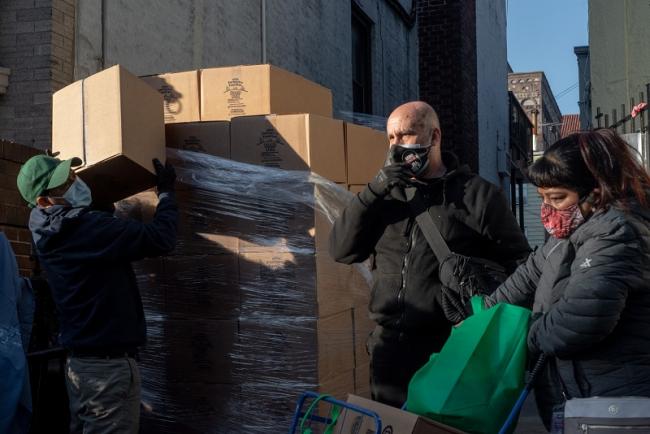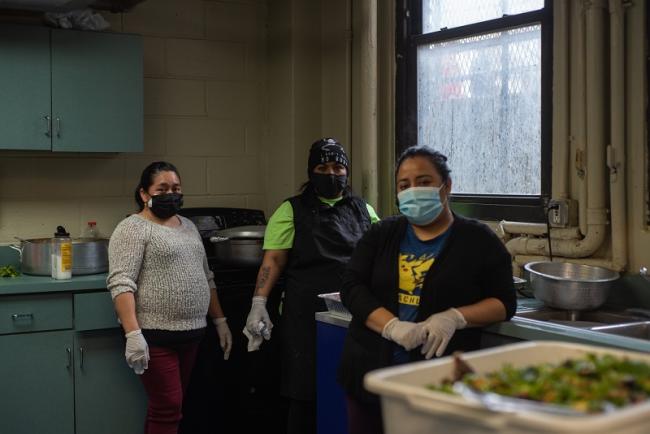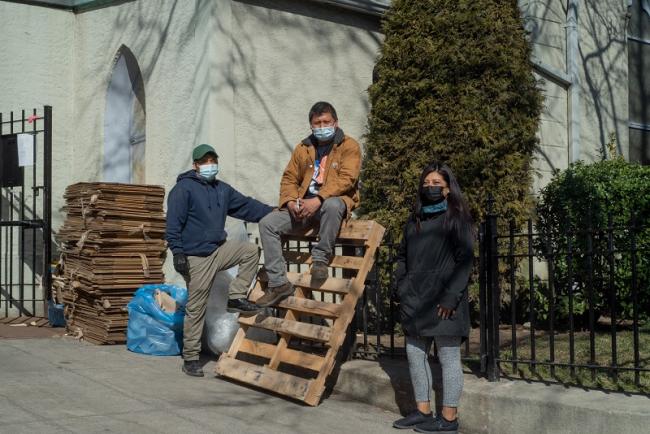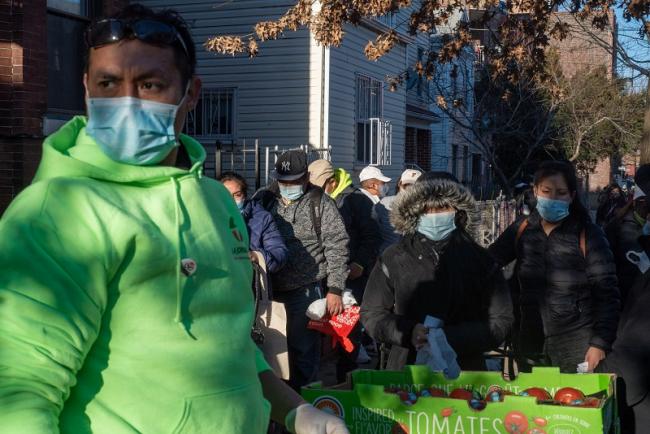
This article was originally published in Spanish in Conexión Migrante.
Translation by Liza Schmidt and Martha Pskowski
March 28, 2020 was a memorable day for many migrants in New York. One of them is Pedro Rodríguez, who woke up at 5 a.m. to drive to the working class neighborhood of Flushing, Queens, where he directs a food bank. He arrived while the sky was still dark, and his first memory is of the flash of lights of a police patrol car. He thought there might have been a murder, but the officer approached him to explain that thousands of people had lined up outside the food bank. The pandemic had arrived.
“Are you Pedro Rodríguez?”
“Yes”
“You have a line more than 20 blocks long.”
“What?”
“Yes, from here to over there. Do you want the National Guard? People are really disorganized, there is no control.”
In the city with the most millionaires in the world, the poor had to leave their homes, break social distancing, and face the risk of infection to get food for their children. Pedro, a businessman from Colombia who has lived in New York for 50 years, had planned to distribute 2,000 food boxes that day at his food bank, La Jornada. But that day 20,000 people lined up.
New York, the favorite location for science fiction movies about the apocalypse, was the first location in the Americas to be hit by the Covid-19 pandemic. The city that never sleeps went silent at the beginning of confinement, and the community of undocumented immigrants was the most impacted.
Academics calculate that there are more than 600,000 undocumented immigrants in the state of New York and that two thirds are of Mexican origin. After surviving nearly four years of the Donald Trump administration and navigating the persecution of the immigration system, now they faced an invisible enemy.
Over the past 20 years, churches and migrant networks have formed in New York to serve Mexican immigrants. They became a lifeline for thousands of families confronting hunger, the coronavirus, and death.
In New York State there are around 150 civil society organizations dedicated to working with the Mexican immigrant community. The oldest have been around for 20 years, experiencing some of New York’s worst crises: the 9/11 attack on the Twin Towers in 2001 and the disaster of Hurricane Sandy in 2012. They have learned to create alliances and work around the rules of the system.
La Coalición Mexicana: Partnerships between Churches, Government, and Academia
La Coalición Mexicana (the Mexican Coalition) started receiving calls from women seeking food at the beginning of March 2020, director Jairo Guzmán remembers. Mexicans also arrived looking for thermometers in those early days, because prices had skyrocketed.
Jairo’s parents brought him from Mexico to New York when he was an adolescent. Today he directs Coalición Mexicana, one of the grassroots organizations that has helped the migrant community, mostly undocumented, for the past 20 years.
The first crisis that Jairo faced was the attack on the Twin Towers in 2001. He worked in the delegation of the Puebla state government in New York and worked searching for victims of Mexican origin.
“We had to help transport loved ones to Mexico and help people who were not legally married so that they could access certain resources,” he explains. “We began working on cases to access 9/11 assistance funds to send to the widows in Mexico. This was possible with the help of other lawyers who worked pro bono. And one of these lawyers helped me form La Coalición.”
In 2020, Jairo lived through the worst pandemic in the last century. From his headquarters in the Bronx, in the annex of a Catholic church, he worked to get funds to buy food and protective equipment and to create health informational materials in Indigenous languages.
“I remember going to the supermarket and not finding meat. We went from one supermarket to another. There weren’t any cleaning supplies, the toilet paper had disappeared. And, suddenly, you got a nervous feeling—is it true or not what is happening?”
To buy food and medical equipment, Jairo wrote letters to philanthropists and foundations. They explained the scale of the problem and the number of families that, based on their 20-year track record, sought help.
La Coalición also contacted Catholic Charities of the Archdiocese of New York and hospitals with which they had previously collaborated. NewYork-Presbyterian, in Upper Manhattan, donated food for 100 families during four months—which later became eight. Their contributions ended up continuing until March of this year. La Coalición’s headquarters now is jammed with donations, diapers, informational materials about Covid tests in different languages, and cloth bags filled with food.
From his experience in the offices of the Puebla government and the New York City Administration for Children’s Services, Jairo learned that government institutions in the United States respond to numbers. When he saw the scale of the emergency during the pandemic, he began to compile statistics.
“We did a survey in the second week of March with the Survey Monkey platform and 160 people responded. We asked [the beneficiaries] if they had enough money to pay for the necessities for 14 days, if they trusted they would get paid, or that the government would help them. We used this information with the New York City Department of Health to say, ‘Look what’s happening. All of this can get worse if you don’t help.’”
In response, the Department of Health sent facemasks, gloves, thermometers, and paid for support staff.
Jairo has also learned that universities can be important allies for civil society.
“I have a good relationship with Columbia University,” says Jairo. “And I spoke with professors who could support the programs we wanted to develop for the well-being of the families. Any project that they wanted to do, we invited the universities to evaluate it and determine whether we were fulfilling our goals or not.”
La Coalición works out of the annex of a Catholic church in the Bronx, thanks to a bishop who works with Jairo. Some of the first waves of Mexican immigrants arrived in the New York City borough over 20 years ago.
Among the families that they have worked with during the pandemic, Jairo remembers in particular a Mexican mother who woke up and found her husband dead.
“Her husband got sick with Covid-19 and died in the room that they were renting. She had to get the ambulance and they took away the body,” he says. “She went out to seek help and [the family they rented from] was worried due to their migratory status. They threw her out of the apartment. Their youngest daughter was only one year old, the oldest was eight. They were little kids and she was left alone with them. She searched for a place to stay, for food, for clothing. The last time we saw her, she was staying with friends in Connecticut.”

The Migrants Who Died of Covid-19
According to public data, over 9,000 Hispanic or Latino people have died of Covid-19 in New York City. Covid-19 death rates are higher for Latino and Black and African-American New Yorkers than the population as a whole.
Many of the migrants who died were the breadwinners in their families. It is still unknown how many children were orphaned during the pandemic. The Administration for Children’s Services said by email that there are “very few” minors who have had to be cared for by other adults—usually members of the same family—due to the death of their parents of Covid-19. Even so, they did not offer information of how many of them are Mexican.
Before the pandemic, most of the migrant community worked cleaning houses, in restaurant kitchens, in construction, and doing deliveries. These workers devote more than 30 percent of their family income to rent payments. They often share housing with other relatives to save on costs. Unemployment hit hard, with 60 percent of these workers losing their jobs, according to the Mayor’s Office of Immigrant Affairs. Thirty six percent of the general population lost their jobs.
Network of Transnational Communities: Náhuatl, Mixteco, and Totonaco Speakers in New York
At his office in the South Bronx, Marco Antonio Castillo, a Mexican anthropologist and activist, explains that he has worked with Indigenous migrant communities for 20 years. He is the director of the Red de Pueblos Transnacionales (Transnational Peoples Network), an organization that celebrates the identity and traditions of Indigenous migrants in the city.
“During the pandemic, it was very clear that not all migrants are equal. The people who don’t feel comfortable speaking Spanish and who don’t know English, usually because they speak an Indigenous language, are more hesitant to seek out help. These people end up living in the shadows,” Marco says during a long day delivering food donations to Latino migrants, with cumbia music playing in the background. “Word spread that in hospitals ‘they will kill you.’ There were a lot of theories and suspicions. People ended up staying at home. Many people died in their homes, suffering from Covid in their rooms, in their houses.”
For those who did call ambulances, it was later difficult to locate their family members in the large network of hospitals. The hospitals were overwhelmed by the emergency, lacking ventilators, and bodies were kept in cold storage trailers, waiting to be claimed. Many of these bodies were identified with name tags that had spelling errors due to miscommunication, or sometimes false names that migrants used to work.
The Network had contributed to creating the first Collective of Indigenous Interpreters in New York, which works with the Health Department to translate informational materials into tu’un saavi (Mixteco), me’phaa’ (Tlapaneco), náhuatl, Mam, and Kichwa.
In New York there are speakers of 21 Indigenous languages originating from Mexico, according to the Endangered Language Alliance.
“Imagine the task of locating family members for an Indigenous migrant. A family member left them in one hospital, but the staff didn't tell them they were transported to another because of the saturation levels,” says Marco. “We located [patients who had been transported] outside of New York City, to Philadelphia, New Jersey, Long Island, upstate New York, five or six hours from here. The Transnational Peoples Network has seven committees in different parts of New York State. Each one communicated with their contacts during the pandemic and sent a daily report of how many cases of deceased or sick people they knew about and tried to locate people whose relatives were looking for them.”
“The idea was to get the whole story. Find out where they had taken a patient and go to the hospital. Sometimes the hospitals did not even have a record of the person because there was no space. Then, you had to identify the ambulance, the name of the person, the day and time they were transported. Ask what other hospital he or she was transferred to. Talk to that other hospital, they locate them and tell you: no, well, I needed a ventilator and there weren't any here. We took him to Philadelphia,” he explains. The Network is self-managed, but when aid began to flow into New York from larger foundations, they became a channel to buy groceries and distribute them to Latino migrant families.
“The people who come from Indigenous communities have significant organizational capital, linked to mayordomías and community festivals. All these networks helped during the pandemic. We made an agreement with American Indian Community House to deliver 1,000 bags of food with eggs, vegetables, cereals, and fruit every month to Indigenous families. There were other foundations with more capital that also offered help. The Network obtained a grant during the emergency to give checks to the most impacted families. They gave out $10,000 in financial aid for rent payment and $20,000 in financial support cards with $200 each.

The Parish of the Good Pastor: Fighting for Dignity
Priest Juan Carlos Ruíz, of the Buen Pastor church in Bay Ridge, Brooklyn, activated the support networks that he’d learned of during the Occupy Sandy movement that formed to help people in New York impacted by the 2012 storm.
“We created this response with the motto ‘los indignados de ayuda mutua’ [mutual aid of the outraged] with 17 centers in the first three months,” said father Juan Carlos. “We started it from the San Jacobo Lutheran Church.”
Father Juan Carlos recalls how some churches acted as warehouses for tools used in rebuilding homes. In others, around 15,000 volunteers cooked 200,000 meals each week, following the hurricane.
The Occupy Wall Street movement had recently begun and joined with a coalition called “Mátrix,” which had support networks coordinating aid efforts.
When the pandemic began, father Juan Carlos offered his resources to help the migrant community. His parish delivered 7,000 pounds of food each week.
His three main volunteers created Whatsapp and Wechat groups and recruited English, Arabic, Mandarin, and Spanish speakers to organize those communities around different schedules. The darkest side of the pandemic was seeing all the deaths up close.
“We had infected people who left detention centers to live in the streets because they didn’t want to get their family sick; people who were found days later because their apartments smelled. And entire families where the adults were sick and the children were healthy, so they had nothing to eat. In addition to all of this, so much terrorism because immigration police never stopped deporting people.”
Ángel Gordillo, a Mexican immigrant originally from Oaxaca, fell sick alongside his wife, Olga, and his brother, René. Father Juan Carlos was one of the few people who brought them food while they were home-bound.
“He was the soul that God put in my path for so many things. Father [Juan Carlos] never left me. He always sent food so that my children could eat,” said Ángel in the apartment where he lives with his three children and 16-year-old nephew.
Ángel’s brother, René, began to struggle to breathe. A couple weeks later, he died in the hospital. René’s youngest son lived in the apartment with Ángel, but his wife and three daughters lived in Oaxaca. Ángel decided to send René’s ashes to Mexico for them. But, in the Mexican consulate, bureaucratic processes complicated his plans. When Ángel found out that father Juan Carlos was planning to take the ashes of another migrant back to Mexico, he spoke with him.
“I got to the consulate and there was a small room of 12 by 12 meters where they had the urns, all the little boxes jumbled together,” father Juan Carlos recalled. “I think that this shows a lack of respect for their lives. This is something that demonstrates how we are treated not only in death but also in life. So I said, [they deserve] at least a kernel, a speck of dignity. I have to make this trip.”
Fuerza Migrante: Lending a Hand on Social Media
Without knowing anyone, Javier Correa, known as “Chalino,” wrote Facebook messages to the members of the Fuerza Migrante platform asking for donations and help delivering food to his community.
Through his efforts, he obtained food for his neighbors. A few weeks later, Fuerza Migrante invited him to create and lead a community assistance group in their network.

Chalino, 37, is tall, and has a mohawk. He originally got involved with migrant movements to send help to Mexico during emergencies like the 2017 Puebla earthquake. Then, he met the members of the Topos brigade, a civilian rescue workers group that was created after the 1985 Mexico City earthquake and continues to offer disaster relief.
From the basement of a building in Manhattan that is being remodeled, Chalino recalls how he decided to go to Hunts Point, one of the largest wholesale markets in the U.S., to ask for donations. After weeks of taking food to his community, they offered him a load of pineapples.
“I remember vividly that they gave us three trucks full of pineapples. Obviously, our neighbors weren’t going to eat just pineapple,” he said. So, he started looking for other options, like food banks, to get food to his neighborhood in Queens.
Chalino migrated to the United States 16 years ago, and believes that he can do much more than just work and send money to his children in Monterrey. He now has a truck that he named the “Fuerza Migrante community aid unit” because it was the first organization that helped him get food for his neighborhood.
Fuerza Migrante is a platform that brings together migrant organizations across the United States with the goal of securing representation in the Mexican Congress. During the pandemic, the binational organization helped migrants contact the Mexican Consulate for help with repatriation.
As a volunteer, Chalino manages one of La Jornada food bank’s 17 food distribution points. Pedro Rodríguez, or Don Pedro, as the volunteers call him, founded La Jornada 12 years ago. Overwhelmed by the need he saw around him, he petitioned the city government and the private food banks Food Bank New York and City Harvest for more food.
Until May, La Jornada had volunteers from 18 countries and 17 food distribution points in Queens. Each week, the organization delivered food for 13,500 families, partnering with other organizations and leaders to increase their reach into the neediest neighborhoods.
New York, City of Migrants
New York is a city with a long history of migration. During the last century, the most significant wave of migrants came from Europe, explains Norma Fuentes, doctor in sociology at the City University of New York (CUNY).
“New York has the oldest legacy of migration in the United States, and is one of the richest cities in the world. It’s the financial center of the world. Many well-known foundations were created by European immigrants that haven’t been replaced for 50 years. Waves of migrants from Latin America and Asia have benefited from this legacy,” she said in a phone interview.
Many migrant organizations in New York are registered 501(c)3 nonprofits, and others work as collectives. Church groups also organize action plans to support migrant communities.
Large foundations like the Robin Hood Foundation were among the first to provide aid for migrants and have learned from each crisis.
“The aid model employed in this city, where there have always been many immigrants and there are many longstanding institutions, is very different to the rescue model for undocumented people arriving in new destinations,” Fuentes said. “There are no institutions there; there’s no ideology around helping and protecting migrants. And many of these places are very conservative.”

Migrants in New York are No Longer Invisible
At the beginning of March, thousands of Latinx migrants organized a protest demanding the approval of a $3 million aid fund. The protestors took the Manhattan and Brooklyn bridges and some went on a hunger strike. They marched all the way to Albany, the New York state capital, to protest in front of the governor’s mansion, occupied by Andrew Cuomo.
This mobilization took place just a few months before the Black Lives Matter movement spread throughout U.S. cities after George Floyd’s murder in Minneapolis.
Last April, the New York Congress approved a $2.1 billion-dollar aid fund to help undocumented immigrants, which will make payouts of up to $15,600 dollars per year to those who lost their jobs during the pandemic.
The fund was approved months after democrat Joe Biden assumed the presidency and is the largest aid package for undocumented migrants in the history of the United States.
“Somehow Trump stirred up so much hidden hate and racism in this country. Trump’s ugliness, in the case of George Floyd [protests] and coronavirus, made migrants look like heroes because they never stopped working,” Fuentes said. She thinks the approved aid package for undocumented immigrants would not have recieved as much attention if not for the protest by second generation immigrants, the children of those who arrived 20 years ago, who marched with pots and brooms.
“It’s thanks to virtual mobilization, to the social media of the second generation, those who speak the language, those who understand cell phones, social networks, Instagram. This is the result of Facebook and of millennials, who are very active,” she said.
The pandemic stoked goodwill. The Mexican migrant community, which has long worked without recognition, began to demand rights. No economic stimulus package will bring back the dead—the fathers, mothers, siblings, and children that Covid-19 took. But this community has shown its capacity to organize and emerge from the shadows in New York City.
Nadia Sanders is an investigative journalist. She studied at the Universidad Autónoma de México, Xochimilco and has a master’s degree in Public Policy Journalism from Centro de Investigación y Docencia Económicas (CIDE). She has covered migration, national security, human rights, gender, and Afro-Mexicans.
Ximena Natera is a visual journalist and editor born and raised in Mexico City. She has been a member of the Red de Periodistas de a Pie since 2013, a national journalist network that trains journalists in contexts of violence in the country. This experience has shaped her practice and understanding of storytelling, focusing her work on human rights violations, stories of resilience, and collective memory processes.

